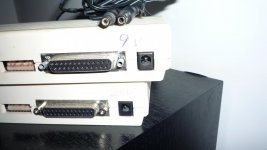Ole Juul
Veteran Member
I just came across two classic USR external modems in my stash. I'll probably never use them, but then who knows. At any rate, I want to match up the power supplies for proper archiving. Does anybody know the voltages?
USRobotics Sportster 1200; FCC ID: CJE794PL1200
USRobotics Sportster 14,000 Fax Modem; FCC ID: CJE-0265
I have two USR adaptors and one is 20VAC and the other is 9.2VAC. I had thought that it was the earlier ones that used 20V., but in this case the 9V., one matches in colour with the 1200. I'm amazed that the USR documentation doesn't have voltages. They just say to make sure to use the one that came with it. Are they hoping you will ignore that (as usual) and in this case blow something. Anyway, if somebody has relevant info, I'd be grateful.
PS: I've now looked at some other brands of external modem in my collection and it seems that AC is normal, and not marking voltage is also standard.
USRobotics Sportster 1200; FCC ID: CJE794PL1200
USRobotics Sportster 14,000 Fax Modem; FCC ID: CJE-0265
I have two USR adaptors and one is 20VAC and the other is 9.2VAC. I had thought that it was the earlier ones that used 20V., but in this case the 9V., one matches in colour with the 1200. I'm amazed that the USR documentation doesn't have voltages. They just say to make sure to use the one that came with it. Are they hoping you will ignore that (as usual) and in this case blow something. Anyway, if somebody has relevant info, I'd be grateful.
PS: I've now looked at some other brands of external modem in my collection and it seems that AC is normal, and not marking voltage is also standard.

